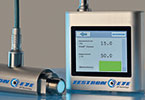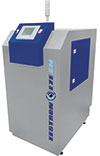
Regular bath monitoring is necessary to ensure consistent results in cleaning processes of electronic assemblies.
There are a wide range of processes available. In addition to the well-known measuring methods, there are now new innovative processes available to ensure the process monitoring and allow complete process management. This article provides an overview of the existing methods, illustrates their possible advantages and disadvantages, and offers insight into the latest technologies of the future.
Bath monitoring objectives and methods
Permanent contamination enters the cleaning and rinsing bath through the cleaning of electronic assemblies. In addition to the contamination, there are also process-dependent influences, such as extraction, evaporation or the spread of cleaner into the rinsing water, which can adversely affect the end result.
Since the cleaning and rinsing areas are affected by this, it is recommended to monitor the bath in these areas, which offers the following advantages:
• Consistent cleaning process due to a constant quality level of the cleaning bath.
• Cost reduction by avoiding premature bath changes.
• Preventing poor cleaning results due to delayed media changes.
• Documentation of the cleaner concentration with a process traceability option, e.g for ISO 9001 – 2008).
There are two well-known procedures, which allow conclusions to be drawn concerning the quality of the respective process stage (Figure 1), for monitoring both the cleaning and the rinsing bath. This involves determining the pH value and the conductivity.

The conductivity is the sum of the ions in the cleaning medium or demineralised water, which is caused by cleaning agents and the removed contamination. This value can be measured using a conductivity meter.

Bath contamination also changes the pH value. The flux contained in the soldering paste, for example, contains organic acids that affect the measurement.
This value can be measured manually using a pH meter (see Figure 2). Alternatively, this can be performed using a potential difference glass electrode integrated into the system.
Both measurement methods are successfully applied in practice and provide the user with information concerning the tendency toward changes in the cleaning or rinsing stage, which can be assessed in terms of a reference value. Additional process parameters, such as temperature, contamination or ageing of the measuring probes, may affect the aforementioned methods, which complicates the interpretability. However, none of the specified methods provide absolute values. They are often no longer sufficient for the widespread aqueous cleaning processes. Users must keep a closer eye on the existing cleaner concentration and its changes.
Meaning of concentration monitoring and manual measurement methods
To achieve the optimum performance of aqueous cleaners, the recommended application concentration must be kept constant within a defined range. If the concentration substantially falls short of the recommended concentration, cleaning quality cannot be ensured. In this case, an additional dosage is necessary.
An excessive application concentration would also unnecessarily increase costs due to the high level of cleaner use. The cleaner manufacturer defines warning and control limits in the process.
Rapid chemical tests constitute one method for manually determining the concentration. They may be based on an acid-base titration. A bath sample of acid or alkali is added until the colour of a test indicator changes. The concentration of the medium to be tested is calculated from the consumed titration medium. It must be noted that the result with this method is affected by the contamination of the bath. In addition, it cannot be applied with pH-neutral cleaning agents.
There is another manual method for determining the concentration based on the phase separation method. Here, a bath sample is added to a reaction solution in a graduated cylinder, which forces a visually identifiable phase separation.
The concentration can be determined by reading the separation. This method can be applied for analysing alkaline and pH-neutral media and is typically resistant to contamination levels.
An alternative manual method for determining the concentration involves measuring the refractive index (sum of the contamination and concentration).
The organic composition in the medium can cause changes in this measurement variable. This measurement is only precise with a fresh bath solution, since the contamination affects the measurement density.
The primary advantages of manual methods are they are inexpensive and easy to perform. These methods are thus ideally suited to perform random measurements in the ongoing process and thus ensure increased safety for the user.
Automatic concentration measurement and management
In contrast to manual processes, automatic processes allow for permanent concentration monitoring and thus seamless documentation. The latter is becoming increasingly important, especially with regard to audits or supplier evaluations.
There are various instruments available on the market that determine the cleaner concentration online. They ensure the continuous monitoring of the cleaning process. However, at the same time, these processes frequently require a complex setup and therefore are not easily integrated into the process.

The measuring accuracy depends on the respective process and is influenced by the entry of contaminants.
However, acoustic measurement methods (for example, see Figure 3) for determining the concentration have established themselves on the market. The key advantage of these methods is the high measurement accuracy, which is guaranteed by three measurement variables instead of just one. A continuous accurate measurement result is guaranteed, even with increasing contamination.

The latest systems, also based on the acoustic measurement method, not only provide complete concentration monitoring but enable an all-in-one solution for the automatic dosing of cleaner concentrate or demineralised water (see Figure 4).
A complete cleaning management system is thus implemented, since the unit independently keeps the set cleaner concentration constant. This can achieve significant time and cost savings, since the user does not have to perform manual measurements/dosing steps. In addition, fewer errors occur during the manufacturing process.
Outlook
In the future, we can expect to see such systems offer an extended range of services. Realistically, the cleaning management system could be further developed to include a cleaning plant as well as several machines. This would allow, for example, three or more cleaning machines to be controlled by a concentration management system in a modern manufacturing environment.
Conclusion
Bath monitoring is an important step to ensure the purity and ultimately the production quality of electronic assemblies. Manual monitoring methods are inexpensive and easy to use alternatives and are also suitable wherever spot checks are required. These procedures, however, cannot provide complete documentation or continuous process traceability.
The alternative to this is automatic measurement methods, which offer high measurement accuracy and stability as well as data recording, especially in the acoustic measurement method. These systems can be expanded to include cleaner monitoring for a comprehensive cleaning management system, which can be implemented according to production requirements.
Overall, users should consult specialists when selecting the process for their own production, so that the most technically and economically sound solution can be implemented.
| Tel: | +27 11 726 6758 |
| Email: | [email protected] |
| www: | www.eispty.co.za |
| Articles: | More information and articles about Electronic Industry Supplies |

© Technews Publishing (Pty) Ltd | All Rights Reserved